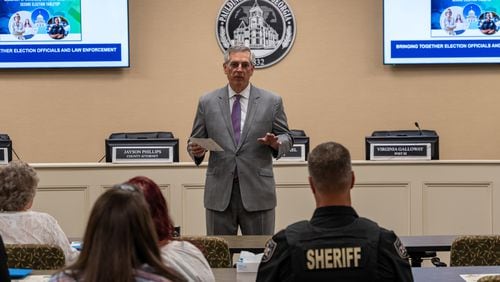About Atlanta Forward 2015
This three-day series kicks off a year-long examination of the economic state of metro Atlanta. The key question we seek to answer: as our region recovers, do we have what it takes to attract the companies, jobs and talent we need to regain our pre-recession prosperity?
We’ll follow this theme all year, deeply reporting the region’s challenges in transportation, education, leadership and more that could stunt our progress. We’ll also examine potential solutions.
We did a similar investigation in 2011. The result was our first Atlanta Forward special report, an eight-day series that illuminated many of the region’s obstacles. Four years later, the region is grappling with the same problems. So we decided to take a fresh look.
- Charles Gay, Senior Editor for Economy/Business
Email: cgay@ajc.com
This initial series:
Sunday: A big-picture comparison of Atlanta with its perennial economic competitors, Charlotte and Dallas.
Monday: A deep look at Dallas-Fort Worth’s Texas-sized ambitions compared against metro Atlanta’s.
Tuesday: Charlotte’s turn under the microscope. While the market is smaller, its vibrant downtown is enviable.
How we got the story
AJC economy reporters Dan Chapman and Michael E. Kanell, with the help of AJC data specialist Jeff Ernsthausen, analyzed reams of economic and social welfare data on the metro regions of Atlanta, Dallas and Charlotte. They then compiled 12 key indicators comparing the regions’ relative prosperity.
The AJC used data from the federal Bureau of Labor Statistics and Bureau of Economic Analysis, as well as the Census Bureau. With data not adjusted for inflation, the AJC calculated to correspond to 2013 dollars for comparison’s sake.
In addition, Chapman traveled to Dallas-Fort Worth and Kanell to Charlotte to report the story behind the numbers.
How we got the story
AJC economy reporters Dan Chapman and Michael E. Kanell, with the help of AJC data specialist Jeff Ernsthausen, analyzed reams of economic and social welfare data on the metro regions of Atlanta, Dallas and Charlotte. They then compiled 12 key indicators comparing the regions’ relative prosperity.
The AJC used data from the federal Bureau of Labor Statistics and Bureau of Economic Analysis, as well as the Census Bureau. With data not adjusted for inflation, the AJC calculated to correspond to 2013 dollars for comparison’s sake.
In addition, Chapman traveled to Dallas-Fort Worth and Kanell to Charlotte to report the story behind the numbers.
Usually, at first, there’s a river. Then man decides he wants to cross it, so he builds a bridge.
Here in North Texas, though, they are building not one, but three bridges over dry land with the expectation that one day a river will run below them.
Texas-sized chutzpah is alive and well in this one-time cow town due west of Dallas. This city recently began construction on the first bridge that will carry people and cars onto Panther Island, an industrial wasteland along the Trinity River slowly transforming into a live-work-play colossus with 10,000 homes and the municipal bones for a new downtown.
INTERACTIVE MAP: Dallas-Fort Worth's big-ticket projects
The audacity of the nearly $1 billion scheme – the nation’s largest urban water project – lies in its plan to carve a 1.5 mile long channel along a curve in the Trinity, thereby creating an island. Canals will be laced throughout the 800-acre development turning this corner of bone-dry Texas into an ersatz Venice of the High Plains.
“Panther Island will change the face of Fort Worth,” Mayor Betsy Price says. “We still do big things in Texas.”
Critics say metro Atlanta could learn from Dallas-Fort Worth’s visions of grandeur. It has been 20 years since Atlantans rallied around any community-shaking event – the Olympics – and the region struggles to tackle its economic, traffic and water woes.
Atlanta’s economic foundation too remains skaky, five years after the recession ended. In a special report Sunday, The Atlanta Journal-Constitution compiled a dozen economic and social welfare indicators, including jobs, wages, GDP, foreclosures, millennial migration and more, and the results show an Atlanta struggling to gain traction.
ATLANTA FORWARD 2015: View the full report
Compared to Dallas-Fort Worth and Charlotte, other contenders for the New South’s crown, Atlanta’s economy lags. The AJC sent reporters to both metro regions to learn what makes the competition strong.
Fort Worth and Dallas routinely tackle major development, transit or infrastructure projects. Big D plans a $2 billion project, including three bridges of its own, to also reconnect with the unheralded Trinity River and 20 miles of adjoining green space.
Bigness, though, has its detractors. Some don’t like their tax dollars subsidizing private developers. Others lament the top-down, bigger-is-better development ethos and the homogeneity of “mixed-use” architectural and cultural fare.
“We have enough people already in Texas,” says Don Woodard Sr., 89, a Fort Worth insurance executive. “They keep tearing down and rebuilding the freeways. We’ve got a real water problem here, yet they keep bringing more people in to put their straw in the lake. Things are not going to get any better.”
Woodard, though, knows that halting growth is like corralling a runaway steer at the famed Fort Worth Stockyards. The city’s population, after all, jumped 50 percent between 2000 and 2013 to nearly 800,000 residents. The city of Atlanta saw only a 7 percent increase, to about 450,000.
“We need to keep up with our neighbors in other large cities of similar size like Atlanta,” says J.D. Granger, who heads the quasi-governmental organization shepherding Panther Island’s development. “If you’re not moving forward as a city, you’ll fall back. The status quo is a slow death.”
Room to grow
Maj. Ripley Arnold established a military outpost along the banks of the Trinity River in June 1849. Downtown Fort Worth eventually blossomed south of the fort; the stockyards, oil refinery, sewage treatment plant and landfill settled on the northern side of the river.
The downtown crowd really didn’t pay much attention to Fort Worth’s industrial heart, or the polluted Trinity, until the early 2000s when the city began casting about for space. The oil and gas bidness was booming and attracting young professionals to the city’s core. About 65,000 people work downtown today. Fort Worth needs room to grow.
The Army corps is undertaking a major engineering project to reduce flooding along the Trinity and U.S. Rep. Kay Granger, a Republican from Fort Worth and J.D.’s mother, supports it strongly in Washington. Re-routing the river, cutting the channel and building a 33-acre lake is part of the corps’ plan.
The Trinity River Vision Authority, run by the younger Granger, and other public and private groups have cleared three-fourths of Panther Island. A music pavilion, minor league ball park, drive-in theater and brewery already line the river. Construction on the bridge stanchions started in November. But the channel is nowhere in sight.
“People say we’re building bridges to nowhere, but, no, we are not,” Mayor Price said. “Building those bridges on dry land costs half as much as building them across a water channel. If you can save money, the people are pretty much OK with that.”
Yet the entire project, so far, has more than doubled in price from $435 million to $910 million due to various upgrades and higher land values amid the region’s natural gas boom.
“It has never been put up to a vote of the people,” grouses Woodward, whose office offers a view of the Trinity. “If it was, the people would turn it down because we’re talking about a billion-dollar enterprise. It’s a boondoggle with a capital B.”
Washington is on the hook for more than half the cost, a dicey proposition in a time of federal belt-tightening. The deepening of Georgia’s Savannah River port, for example, also needs $400 million in federal money.
J.D. Granger says about two-thirds of the local share is in hand after parlaying future tax collections into subsidies for developers to build Panther Island.
“We have to go forward (and) be willing to invest in our future,” Granger says. “The only question, really, is, ‘Do we do it the right way or the cheap way?’”
Panther Island is envisioned as a new wave of urban living with 25,000 residents and a denser, transit-friendly community with canals and other waterfront housing. Fort Worth targets millennials – the 25-34 year old urban enthusiasts with brains and buying power – to energize Panther Island and the economy as a whole.
“We can talk about information technology or oil, but the most important commodity right now is young professionals,” Granger says. “That’s the asset that brings a city the highest return.”
Dallas-Fort Worth’s population of college-educated millenials grew 20 percent between 2000 and 2012, according to the City Observatory think tank, while Atlanta’s ticked up 3 percent.
Shared riverfront
Dallas shares the Trinity River with Fort Worth and has its own out-sized plans to reincorporate the river into the city scene. Nowhere is the ambition as pronounced than at the river’s western edge, across from downtown, where Phil Romano and partners plan a $2 billion mix of condos, retail and office towers in a once-forlorn strip of auto repair shops and taquerias.
But first there is the “restaurant incubator.”
Romano, who created Fuddruckers, Eatzi’s and Romano’s Macaroni Grill, quietly began buying up 100 acres of West Dallas property a decade ago. He knew downtown would one day run out of room. But what to do with blocks of shotgun shacks and corrugated-steel warehouses in the neighborhood where Bonnie met Clyde in 1930?
Romano first envisioned a new financial district, then a clean energy corridor.
“But then I thought I should be creating concepts that people want,” he recalls.
Romano discarded the developer’s time-tested playbook – build homes first to ensure a steady stream of passersby – and opened 15 restaurants, a microbrewery and specialty food shops. He sought new culinary trends and chefs hungry enough to compete for restaurant space and financial backing.
He promised up to $500,000 to get a chef’s idea off the ground, in return taking a 50 percent stake and the option to take a concept national.
Roger Staubach, the former Cowboys quarterback turned developer, is building a $100 million apartment project in the heart of Trinity Groves. A 10-block area of offices, condos and hotels, art galleries and shops is planned around a light-rail stop.
“Anybody can go anyplace for good restaurants,” says Romano. “But Trinity Groves is the most recognizable destination in Dallas. Where is it? At the end of the bridge.”
That would be the $182 million Margaret Hunt Hill bridge, designed by renowned Spanish architect Santiago Calatrava. The city of Dallas, which put up $28 million of the cost, envisioned the bone-white, cable-stayed bridge as a catalyst for west-side development. The city has also offered millions in tax free subsidies to lure developers to Trinity Groves.
Virtually every billion-dollar project across the Dallas-Fort Worth region depends on government largesse, despite Texans’ antipathy towards government and taxes.
The Trinity River Corridor Project, a $2 billion plan to reconnect Dallas with the river with bridges, lakes, parks and a toll road, began with a $250 million bond referendum in 1998. Private donations and public money built the $110 million Klyde Warren Park, a 5-acre green space that sits atop a downtown Dallas freeway.
“A city can’t do this on its own,” says Price, the Fort Worth mayor. “You’ve got to get the commitment well ahead of time from your federal, state, city and county partners. And you’ve got to start communicating with citizens quite a bit. If you do, your economy and quality of life will benefit.”





